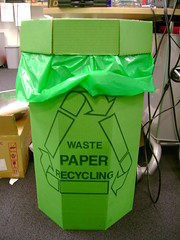 Image by Getty Images via Daylife
Image by Getty Images via DaylifeMarlene Affeld
More and more people are electing to avoid the risk of chemical contamination of their bodies, families and homes. Fortunately, solutions for addressing change exist and are within easy access. Choosing eco-friendly alternatives allows us to live a natural, green lifestyle.
The benefits of organic bedding, eating organic foods and wearing organic clothing are numerous. Organic Foods The Organic Food Association tells us: “It's common sense; organic food is good food. Good to eat, good for the environment, good for the small-scale farmers and farm workers who produce it.”
Organic farming is all about health and wellness. In order to assure optimum health and resistance against diseases, the natural balance in our own bodies and in the environment must be maintained. The use of artificial chemical pesticides, fungicides, herbicides, fertilizers, genetic engineering and drugs interfere with this delicate balance; with unknown and often harmful consequences! This is why organic farming impacts on much more than what can be tasted or seen.
Over the last fifty years, commercial farmers have, of necessity, continued to increase the amount of these hazardous applications. Cereal crops are sprayed as many as 8 times during the growing season. Many fruit and vegetable harvests have been sprayed 10 - 15 times. After harvesting the spraying process is repeated to inhibit grow of bacteria during storage and transport. Excessive spraying of fruit and vegetable crops destroys natural bacteria, leaving the plants increasingly vulnerable to attack from unwelcome pests or disease. More over insecticides and fungicides are then required to fight off infestation and decay. However, these pests rather quickly become immune to the chemicals applied and their population increases rapidly. More powerful and increasingly toxic chemicals are then required.
Organic certification is the consumer’s assurance that products have met stringent standards and have been grown and handled according to strict procedures without contamination from carcinogenic pesticides, fertilizers, human waste or sewage sludge and that they were processed without ionizing radiation or artificial food additives. Organic or non-organic, which would you rather put in your body? We are what we eat. When our diet is built upon natural organic choices we are providing our bodies optimum food, produced in optimum conditions. Organically raised vegetables and fruit provide more minerals and nutrients than commercially grown produce and are more intensely endowed with color, scent and flavor; they just taste better!
Organic meats are produced from animals that have been treated humanely and raised on certified organic pastures and feeds. Organic meat is the only meat product that guarantees that genetically modified organisms (GMOs) have not been used at any stage of growth production.
Organics And The Environment
The USDA estimates that within the next ten years half of all America’s farm products will come from only 1% of the farms. The EPA also states that commercial agriculture is accountable for 70% of the pollution in our country's rivers and streams. Small-scale organic farmers finance innovative and far reaching research designed to minimize agriculture’s impact on the environment. They preserve bio-diversity by planting heirloom varieties of plants and harvesting seeds for future crops. The loss of a large variety of species is one of the worlds most pressing environmental concerns. The good news is that many organic farmers and gardeners have been gathering, preserving seeds and growing unusual and unique varieties for decades.
Organic farming methods naturally enrich the soil with manure and compost. Well balanced soils product healthy, strong plants, nourishing for both people and animals. Organic agriculture can be a lifeline for small farms as it offers an alternative market where sellers can command fair and equatable prices for crops. Organic farming may be one of the last ways to assure the survival of both our ecosystems and our rural farming communities .
Conventional farming endangers farm workers and their families. Scientific research confirms pesticide-related health problems which include cancer, birth defects, memory loss, paralysis and death. Unsecured storage, improper application methods and unsafe handling and transportation procedures are not at all uncommon and often lead to tragic mishaps. As pests develop resistance, farmers desperate to maintain or increase crop yields often resort to more and more applications of expensive and stronger chemical products. Facing rising costs, depleted fields and contaminated ground water, many small farmers have been forced to abandon their livelihood.
Organic farming, on the other hand, is not only safer and healthier for farmers, but also promotes just compensation in the supply chain. Organic farming provides an economically viable and socially acceptable alternative to large-scale farming and the accompanying dependence on government crop subsidies. Support of the small farmer supports America’s economy.
Organic production dramatically reduces health risks. Many EPA-approved pesticides were registered and approved prior to extensive research linking these noxious chemicals to cancer and other significant health problems. Crop dusting has often resulted in drifts of toxic pesticides from fields to residential areas.
Organic agriculture is one way to prevent more of these chemicals from contaminating the earth that sustains us. An increasing body of research indicates that pesticides and other contaminants are considerably more prevalent in the foods we eat, in our bodies and in the environment than we previously believed.
By choosing organic products we lessen this toxic burden. Organic farmers regularly rotate crops and plant cover crops to control weeds, nutrient leaching and erosion. Soil is the foundation of the food chain. The focus of organic farming is to use methods that build and maintain healthy and sustainable soils.
Organic Skin Care And Personal Products
Skin care and cosmetics are the least regulated products under the US Federal Food, Drug and Cosmetic Act. Whether it is soap, moisturizers or deodorants, skin care products are an essential part of daily life. But do we really understand what these products actually contain and what we are forcing our skin to absorb?
Have you ever suffered from stinging, burning or itchy skin? Chances are that your skin absorbed irritants and toxins from your skin care products. The skin absorbs ingredients in all the personal care products that come in contact with our skin. Consider nicotine or HRT patches. They rely solely on skin absorption.
As mothers we are always concerned for the well being of our children. We tenderly comfort and bathe them with a wide range of products. These include soaps, shampoos, creams and lotions, many of which are used on baby’s tender skin several times a day. The skin is the largest organ of the body and the delicate skin of an infant can be up to 100 times more sensitive and receptive to toxic chemicals and irritating ingredients that the skin of an adult.
Without even realizing, parents put their babies at risk daily. Did you know that applying baby powder to your baby’s skin may pose a cancer risk later in life? The principle ingredient in many baby powders is talc, which several medical studies have confirmed as a known carcinogenic.
Lanolin is a main ingredient in many personal care products and when processed from organically raised sheep, is a wonderful healing balm. The danger lies in non-organic lanolin that has been processed from sheep that were dipped or sprayed for lice with chemical pesticides that are contaminated with carcinogenic ingredients such as DDT, dieldrin or lindane. The residue of these toxin remains in the processed lanolin and can cause severe reactions and long term health hazards.
Chemical free and natural, organic products offer earth friendly options that eliminate these dangers. You can avoid these and similar safely concerns by using only certified organic products formulated from natural sources such as plants, fruits, vegetables and flowers. These products to do not contain synthetic chemicals such as lauryl sulphate, phthales, parabens, artificial fragrances or dyes.
Organic Textiles
By the end of 2008, the sale of organic textiles worldwide is expected to exceed $3 billion indicating that global demand for organic textiles is increasing in response to consumer demand. Organic production takes more time, requires more skills and knowledge, and at least for now, costs somewhat more. But it is worth it as organic materials do not contain any hidden costs to the environment.
Choose Earth Friendly Products! Choose Organic!
The consumption and use of green technologies is all about the challenges and choices we face if we are to enjoy a high quality of life within the limited resources of our world. If we become passionate about sustainability, together we can make the planet a cleaner and healthier place for all of us to live.
Do you wish to embrace a lifestyle that protects our children’s future? Do you want to to live in the greenest environment possible with a conscience and respect and appreciation for the earth? The quality of life for future generations is dependent on the choices we make today!
Surveys reflect that about a fourth of the US adult population has a profound sense of environmental enlightenment and social responsibility. Almost half of us will buy organic and make earth friendly choices in many aspects of our daily living. Consumer education and awareness is a powerful force for change.
The consumption of organically grown products has increase by 20 per cent in the last year alone. Organic alternatives are readily available and the trend is escalating. Sustainability should be within everyone’s reach. Our choices matter and have a long term global impact. Let’s Choose wisely!
 Image via Wikipedia
Image via Wikipedia![Reblog this post [with Zemanta]](http://img.zemanta.com/reblog_e.png?x-id=c1f28722-71d0-4dbf-a978-4402af4eea56)

![Reblog this post [with Zemanta]](http://img.zemanta.com/reblog_e.png?x-id=1c514aa4-c33b-477e-91af-98c8266a83ed)

![Reblog this post [with Zemanta]](http://img.zemanta.com/reblog_e.png?x-id=3924a8a9-82df-48aa-8ff9-ad70cb148249)

![Reblog this post [with Zemanta]](http://img.zemanta.com/reblog_e.png?x-id=21c66fc9-f49e-4542-aa4a-7843819de731)

![Reblog this post [with Zemanta]](http://img.zemanta.com/reblog_e.png?x-id=ebed341e-9fb2-4229-a5ec-30adbcc0bcff)
![Reblog this post [with Zemanta]](http://img.zemanta.com/reblog_e.png?x-id=801dd145-c20a-45db-96d8-9704243d508d)
![Reblog this post [with Zemanta]](http://img.zemanta.com/reblog_e.png?x-id=80b3a1e4-f23e-4ae4-a1ff-a50e8cfaff81)

![Reblog this post [with Zemanta]](http://img.zemanta.com/reblog_e.png?x-id=3b8b864d-dc43-451a-9792-7caaca8a3ea9)

![Reblog this post [with Zemanta]](http://img.zemanta.com/reblog_e.png?x-id=d756f1c5-0aa0-4d0c-8ba0-0d95ea648d02)

![Reblog this post [with Zemanta]](http://img.zemanta.com/reblog_e.png?x-id=276cba77-5e2a-4c76-8d03-d631e0789ad6)

![Reblog this post [with Zemanta]](http://img.zemanta.com/reblog_e.png?x-id=7565a53c-1bc8-4c56-8cf6-f608caf135ad)

![Reblog this post [with Zemanta]](http://img.zemanta.com/reblog_e.png?x-id=fe6d1053-818d-46e6-8303-ba40723c3058)

![Reblog this post [with Zemanta]](http://img.zemanta.com/reblog_e.png?x-id=adfd8e78-d628-4c23-bba8-cd398dbd4825)

![Reblog this post [with Zemanta]](http://img.zemanta.com/reblog_e.png?x-id=6f1babe3-ba27-4932-af87-7dafad304d63)

![Reblog this post [with Zemanta]](http://img.zemanta.com/reblog_e.png?x-id=994440eb-42a5-46be-8f33-8639adfce021)

![Reblog this post [with Zemanta]](http://img.zemanta.com/reblog_e.png?x-id=3bef42a3-7760-458f-887b-fc087b289248)

![Reblog this post [with Zemanta]](http://img.zemanta.com/reblog_e.png?x-id=237c97df-0beb-4858-9053-5d907adcb697)
![Reblog this post [with Zemanta]](http://img.zemanta.com/reblog_e.png?x-id=be186bf5-01be-49fc-bcb8-351ca554b82d)

![Reblog this post [with Zemanta]](http://img.zemanta.com/reblog_e.png?x-id=655fb0a0-cd45-4a6c-9fe6-9e137a626e3a)